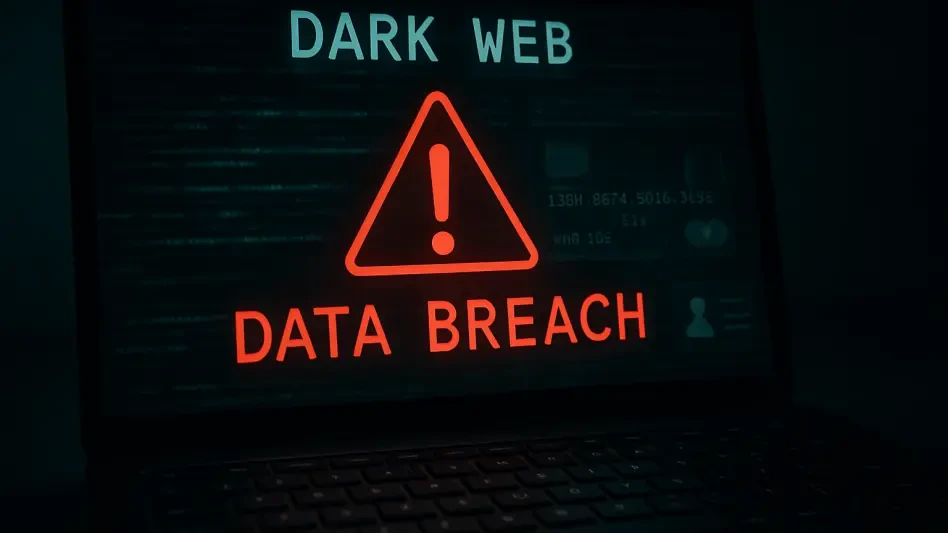In an era where digital connectivity defines daily life, the shadowy underbelly of the internet known as the dark web has emerged as a thriving marketplace for stolen personal information, putting countless individuals and organizations at risk after cyberattacks. Recent years have seen a surge in data breaches targeting major Australian companies like Qantas, iiNet, and Western Sydney University, exposing sensitive details such as phone numbers, passwords, and even medical records. This alarming trend reveals not only the sophistication of cybercrime but also the vulnerability of even the most established entities. Once stolen, this data becomes a commodity in an underground economy, traded and exploited for nefarious purposes. The consequences for victims can be devastating, ranging from identity theft to financial fraud, while the broader implications challenge societal trust in digital systems. This exploration delves into the mechanisms of this hidden market, the challenges of combating data exposure, and the expert insights shaping the fight against escalating cyber threats.
Unpacking the Underground Data Trade
From Breach to Black Market Sale
The journey of personal data from a corporate breach to the dark web is a swift and sinister process that underscores the efficiency of cybercriminal networks. Once attackers infiltrate a system, they extract valuable information—think email addresses, credit card numbers, or driver’s license details—and quickly move to monetize their haul. This data is often listed for sale on hidden forums and marketplaces, accessible only through specialized software that ensures anonymity. The value of such information fluctuates based on several factors, including the type of data, its volume, and how recently it was stolen. For instance, fresh medical records can command prices as high as $1,500 due to their potential for complex fraud, while basic credit card details might sell for a mere $7. This pricing dynamic reflects a chilling reality: personal information is no longer just private; it’s a currency in a shadowy economy where demand perpetually fuels supply.
Beyond the initial sale, stolen data rarely stays with one buyer, creating a ripple effect of risk that compounds the danger for victims. Information often changes hands multiple times, sold and resold to various actors with different malicious intents. A single set of credentials might be used by one criminal for a phishing scam, by another for identity theft, and by yet another for insurance fraud. This constant circulation means that individuals remain vulnerable long after the initial breach, with little ability to track or stop the misuse of their data. The dark web’s structure, built on layers of encryption and anonymity, facilitates this endless trading cycle, making it a formidable challenge for authorities to intervene. As a result, the impact of a breach extends far beyond the moment of theft, embedding itself into a persistent threat that can resurface at any time.
Extortion Through Digital Blackmail
Cybercriminals have honed tactics like ransomware to turn stolen data into a direct weapon against organizations, pressuring them for financial gain with ruthless precision. In these attacks, hackers infiltrate systems, encrypt critical files, or threaten to leak sensitive information unless a hefty ransom is paid. The scale of this problem is staggering—global ransom payments reached an unprecedented $1.7 billion in recent records, illustrating the lucrative nature of such schemes. Companies face not only the immediate financial burden but also the potential for severe reputational damage if customer data is exposed. This dual threat creates immense pressure to comply with demands, even though payment offers no guarantee that data won’t still be sold or leaked on the dark web. The profitability of ransomware has cemented it as a go-to strategy for attackers, driving an alarming increase in cybercrime activity.
The ripple effects of ransomware extend beyond individual organizations, influencing broader trends in cybersecurity and corporate strategy. As attackers reinvest their gains into developing more sophisticated tools and techniques, the cycle of breaches and extortion becomes harder to break. Smaller businesses, often lacking robust defenses, are increasingly targeted alongside larger entities, widening the scope of potential victims. The financial incentive also attracts a growing number of criminal groups to the dark web, where they can access ready-made ransomware kits or collaborate with other hackers. This democratization of cybercrime tools lowers the barrier to entry, ensuring that even less-skilled actors can participate in high-stakes attacks. Consequently, the persistent threat of extortion looms over industries worldwide, highlighting the urgent need for stronger preventive measures and rapid response protocols to mitigate these pervasive dangers.
Barriers to Securing Stolen Information
Persistent Exposure in Hidden Markets
Once personal data lands on the dark web, the harsh truth is that it becomes nearly impossible to remove, leaving individuals and organizations in a state of perpetual vulnerability. The architecture of these underground platforms, designed to shield users’ identities through encryption and anonymizing tools, ensures that stolen information can circulate indefinitely. A leaked password or medical record might be traded for years, resurfacing in new scams or fraud schemes long after the original breach. Victims have virtually no control over this process, as even if one marketplace is shut down, the data often migrates to another hidden corner of the internet. This irreversibility transforms a single incident into a long-term threat, where the potential for misuse lingers without a clear endpoint or resolution in sight.
Efforts by law enforcement to disrupt these criminal networks face significant obstacles due to the dark web’s global and decentralized nature. Agencies like the Australian Federal Police work tirelessly to dismantle illegal marketplaces and apprehend key players, often collaborating with international partners to track cross-border activities. However, the anonymity that defines the dark web allows operators to quickly adapt, relocating their operations or creating new platforms to evade detection. While high-profile takedowns occasionally make headlines, they represent only a fraction of the broader ecosystem, where countless smaller forums continue to thrive. This cat-and-mouse game underscores the limitations of reactive measures, as completely eradicating stolen data from circulation remains an elusive goal, pushing the focus toward prevention and damage control for those already affected.
The Human Factor in Cyber Vulnerabilities
A critical weak point in the battle against data breaches lies not in technology but in human behavior, which cybercriminals exploit with alarming success. Employees, often unaware of the risks, frequently fall victim to sophisticated phishing emails or social engineering tactics that trick them into revealing sensitive information or granting access to secure systems. These attacks prey on trust and curiosity, using deceptive messages that mimic legitimate communications to lower defenses. A single click on a malicious link or an unintended disclosure of a password can open the door to a devastating breach, compromising entire networks. This recurring issue highlights that even the most advanced security tools are rendered ineffective if the human element remains unprotected against such manipulative strategies.
Addressing this vulnerability requires a shift in focus from purely technological solutions to comprehensive education and training initiatives. Many breaches could be prevented if staff were better equipped to recognize suspicious activity, such as emails with unusual requests or unfamiliar senders. Organizations must prioritize regular cybersecurity awareness programs that simulate real-world threats and teach best practices for safeguarding data. Additionally, enforcing strict policies like multi-factor authentication can add layers of defense, reducing the impact of a compromised credential. However, the challenge lies in fostering a culture of vigilance without overwhelming employees, as overburdening them with complex protocols can lead to complacency. Until human error is systematically minimized, it will continue to serve as the primary entry point for attackers seeking to harvest data for the dark web’s insatiable market.
Perspectives on a Growing Cyber Threat
Rising Attacks Amid Security Investments
Despite significant investments in cybersecurity infrastructure, experts like Tyler McGee from McAfee and Tony Jarvis from Darktrace caution that the frequency and sophistication of cyberattacks are only set to increase. The dark web data economy remains a powerful motivator, with the high profitability of stolen information driving relentless innovation among criminals. Even as organizations bolster their defenses with advanced software and protocols, attackers continuously adapt, exploiting new vulnerabilities and refining their methods. This arms race shows no signs of slowing, as the financial rewards—evidenced by billions in ransom payments and data sales—ensure a steady stream of motivated adversaries. The consensus is clear: no amount of spending can fully eliminate the threat when the underground market offers such lucrative returns.
This persistent escalation reveals a deeper systemic challenge within the cybersecurity landscape that transcends individual breaches or attacks. Many organizations, especially smaller ones, struggle to keep pace with rapidly evolving threats due to limited resources or expertise, leaving gaps that cybercriminals eagerly exploit. Larger entities, while better equipped, often face complex supply chains or third-party dependencies that introduce additional risks. The dark web thrives on these inconsistencies, providing a platform where even minor lapses can be turned into major gains. Experts argue that a more collaborative approach—sharing threat intelligence across industries and borders—could help level the playing field. Yet, as long as the economic incentives remain, the trajectory of cybercrime points upward, demanding constant vigilance and adaptation from all sectors.
Policy and Awareness as Defense Pillars
In response to the mounting threat of data breaches, societal and governmental efforts have gained momentum, with initiatives like the 2024 Cyber Security Act in Australia marking a significant step toward stronger protections. This legislation mandates reporting of ransomware incidents and establishes oversight bodies to review and respond to cyber events, reflecting a growing recognition of cybercrime as a national security concern. The Australian Federal Police also plays a pivotal role, targeting dark web marketplaces through international cooperation and intelligence-driven operations. However, while these measures aim to disrupt criminal activities and hold perpetrators accountable, they often address symptoms rather than root causes, as the anonymity of the dark web continues to shield many operators from prosecution.
Complementing policy with public education forms a crucial pillar in the defense against cyber threats, as technological solutions alone cannot bridge the gap left by human error. Raising awareness about safe online practices—such as recognizing phishing attempts, using strong passwords, and monitoring financial accounts—empowers individuals to act as the first line of defense. Organizations must also invest in ongoing training to ensure employees remain alert to evolving tactics used by cybercriminals. Experts emphasize that proactive steps, taken immediately after a suspected breach, can significantly reduce harm, even if data has already entered the dark web. Looking back, the collective response to past breaches showed a gradual shift toward integrating education with policy, a trend that proved essential in building resilience against an ever-present digital danger. Moving forward, sustained focus on these dual strategies offers the most promising path to curb the impact of underground data markets.








